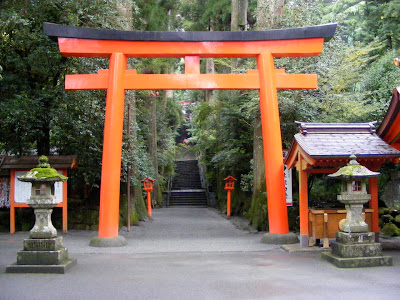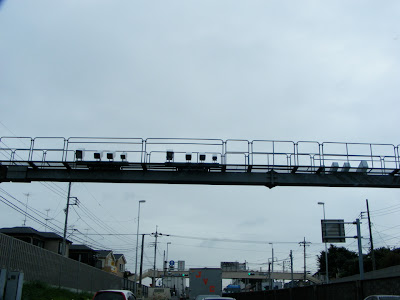Hakone is famous for views of Fuji and for the red Torii gate rising up in the lake edge at Hakone jinja. The old post road from Hakone then descended in a string of hairpins to the tourist gateway town to the Fuji area, Yamoto, past some hideous ticky-tacky private Buddhist and Shinto temples with gold painted ersatz images, guard dogs and surveillance cameras, and spent the night tucked into the entrance to one of the old post road walking tracks. However Fuji is renowned in Japan as a very shy lady, so although I have seen it in the past, I have resorted to a journalistic foray to snap all the images of Fuji I can find, on tourist town billboards, the internet, on manholes, on pottery and even on kimonos. We will eventually come to see her directly glimpsed in the sunset as we take the slow train from Tokyo to our last two weeks in Kyoto.















































 Next to the jinja there was a museum with art works, pictures of Hakone festivals and artifacts from the history of the region.
Next to the jinja there was a museum with art works, pictures of Hakone festivals and artifacts from the history of the region.



From Hakone, we headed down out of the mountains to the coastal plain.





Just as we descended the last slopes, we stopped at a short remaining section of the "Old Post Road" we had seen at Magome and Tsumago, a winding stome walkway through the forest.





Just below this we stopped and snuck into a strange private temple owned by a rich master with security guards and locked gates, very nicely painted with a profligate gold pagoda more reminiscent of a gangster's life than other worldly spiritual pursuits, although I may be wrong.




Just below here we stopped in a little niche beside the road on our last overnight stop before our return.



The next day we returned to Hyoshi, the suburb of Tokyo-Yokohama where we had leased the van through boisterous traffic on the 255, 246, 409 and local hexagon 2 . By this time I really felt the I had learned to become a fearless Japanese driver riding the lights in convoy volleys as they all change phase in programmed sequence to let a cohort of traffic move at speed through about a kilometre of intersections at a time the same way they do in New York.
Having cleaned out the van at a Lawson Station snack bar outlet because it is one of the few places you can dispose of rubbish, we finally arrived at 1 pm sharp to return the van five weeks after we had leased it for two, having faxed Kashiwa a note in Japanese and English translated by a helpful bank clerk in Tono so he would know we hadn't stolen it. Kashiwa was delighted to see us return with the van and shouted us both a lunch of Japanese noodles at the bar over the road. By evening we had finally made it back to Yoshida House in Tokyo again anonymous and apparently unscathed from the diabolical threats of instant fine or highway infringements which could bust the meagre budget of an impecunious traveler from New Zealand.



Japan's fixation on doll-like images of woman shows clearly that the cliche of the fecund female as the nubile fertile child-like adolescent figure is not just a product of Western anorexia nervosa. Images of the doll-like geisha transfixed in her kimono extend through the soft-core girlie comics and magazines that litter every Lawson Station and Seven-eleven snack bar outlet, through kamakaze mini-skirted school girls, to young women carefully made up to look fragile to perfection as a cherry blossom petal, yet seductively adorned with clothes simulating a partially undressed state.

This is possible partly because Japan's rule obeying and Buddhist non-violent mentality results in a low incidence of sex and other crimes and girls feel safe to walk in the street, even at night, without fear of attack. The seductive younger generation contrasts antipodally with the gentle forbearing conservative image of the older generation, leaving the statistics of Japanese people claiming to make love on average only 31 times a year, compared with the 144 times for New Zealanders, a mystery spanning the generations.
























0 件のコメント:
コメントを投稿